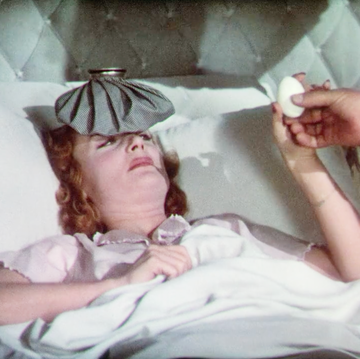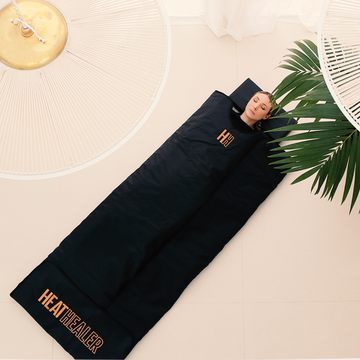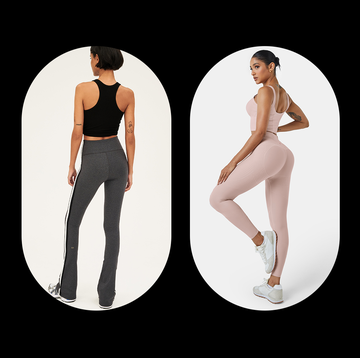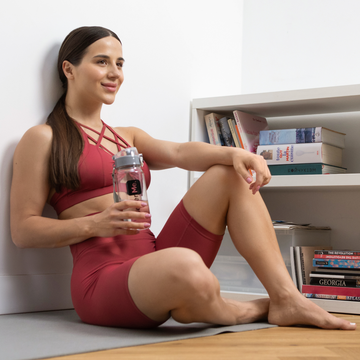Any expert will tell you that sitting too long is a bad idea: When you plop down on your butt, you shorten your hip flexors (the muscles in front of your hips) and overstretch your glutes (the muscles in your butt). If you spend the bulk of your days on your butt, you'll end up with stiff muscles that don't work quite as well when you finally stand up. Over time, this stiffness can shorten your stride and make it difficult to walk comfortably and efficiently, says Dr. Mark Cucuzzella, a professor of family medicine at West Virginia University School of Medicine and medical advisor for BackJoy, a company that develops gear to improve posture.
But things get even more dire when you sit incorrectly: Your spine is designed to support pressure head-on — it holds the weight of your head against gravity — but certain sitting positions mess with that alignment.
Of course, you can't spend the rest of your life on your feet. But if you want to avoid back and neck issues, headaches, and shooting pains down your arms and legs, avoid these mistakes to fend off some of the side effects of sitting:
1. You hunch over.
When you let your shoulders roll forward, your pelvis naturally tilts backward to compensate and keep you from keeling forward. This creates a C-curve in your spine. Because your spine is stacked to handle force that presses directly downward (i.e. gravity and the weight of your head), this curved position sets you up for pain and strain.
To unwind, roll your shoulders up and backward. Then turn your palms forward with your arms against your sides. Imagine tucking your shoulder blades into your back pockets, and voilà: perfect posture!
2. You sit on a cushy chair or pillow.
When you sit on a pillow, bed, or cushy couch, your butt sinks in and your pelvis tilts backward. When your pelvis tilts out of its neutral position, your body has to work harder to keep your body upright, and you can't really relax comfortably. Choose a flat place to plop down (like a bench or hard chair) to avoid overworking everything.
3. You lean back.
Unless you're in a car or airplane, when you're resisting the force of moving forward, you don't need to support your back when you sit, Dr. Cucuzzella says. If you tend to lean back, it's probably because you're sitting on a surface that's unsupportive (see No. 2).
4. You look into your lap.
When you let your head hang down to read on your phone or device, the weight of your head pulls at your spine, which puts stress on your upper back and can cause tension headaches. So while an average head weighs 10 to 12 pounds, tilting your head forward can make it feel as heavy as 60 pounds, according to a new study recently published in the journal Surgical Technology International. If you must look up or down, move your eyeballs instead of your entire body.
5. You cross your legs.
This subtly tilts one hip upward, which can ultimately strain your spine. Keep your knees square to your hips to keep everything in line.
6. Your seat is too low.
This makes you sink into said seat. The results: Your pelvis tucks backward, your spine curves, and your head tilts forward. Keep your body at a 90-degree angle to your thighs to keep your spine aligned.
7. Your feet dangle.
If your stool or chair is too high, and your legs hang limply over the seat of the chair, gravity pulls your feet toward the ground. This tilts your pelvis backward and throws your balance off so the muscles in your core have to kick in to compensate. Unlike a solid set of crunches, this kind of workout can cause pain.
Ideally, your thighs should be parallel to the ground. Because most stools don't promote perfect posture, use the footrest to provide some support, or lower your chair to place your feet on the ground with your knees bent at a 90-degree angle.
8. You sit too far back in the seat.
If you have long thighs, fine. Sit back as far as you need to to keep your knees level with your hips. But if you have shorter thighs, sitting toward the back of the chair will make your feet dangle.
9. On the ground, you sprawl back with your arms on the floor.
This tucks your pelvis backward in a way that messes with your spine's natural curve. Instead, kneel with the tops of your feet on the ground, and sit up straight. This stretches out the feet, a good thing considering the muscles on top of your feet are connected to your shin muscles, and any shoes (including running sneakers) that turn up at the toe actually shorten those muscles and impair your flexibility and mobility. If you're super flexible, you can squat: Keep your heels together, toes pointed outward, and chest up. In this position, your spinal alignment is the same as it is when you stand, Dr. Cucuzzella says.
10. Your focal point is below or above your eyes.
The best position for your phone or TV screen or computer screen is right at eye level. Look up, and you'll shorten and strain the muscles in your neck. Look down, and the muscles in your neck and back will have to work extra hard to support your head. Adjust the screen or your chair if you use the set-up regularly.
11. You lean on the arms of your chair.
Arm chairs are designed to support your body, but with ideal posture, your body should be able to support itself. Chair arms end up repositioning your limbs in an abnormal position (like with your shoulders scrunched up instead of relaxed). Don't use the arms, or adjust them before you do so the support is right beneath your elbows.
12. You sit at your desk for ridiculously long periods of time.
Living in a desk chair is just about the worst thing you can do for your body, according to Dr. Cucuzzella. Find a standing desk hack here, and stand as much as possible throughout the day. At the very least, shoot for at least 10 minutes on your feet every hour, whether that's a bathroom run or water break or walk around the block. Or just get up and stretch near your desk: Do lunges, or swing one leg at a time from left to right and from front to back to unwind your shortened hip flexors and stretch out your glutes. It's so worth looking like the office crazy.
Follow Elizabeth on Twitter.

Elizabeth Narins is a Brooklyn, NY-based writer and a former senior editor at Cosmopolitan.com, where she wrote about fitness, health, and more. Follow her at @ejnarins.













